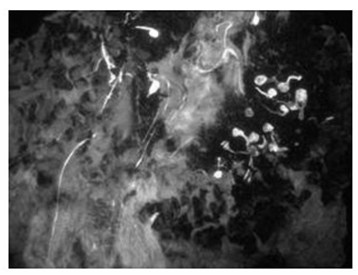Method for quickly identifying cross-compatibility of rose hybrida
An identification method and affinity technology, which is applied in the field of plant reproductive biology, can solve the problems of wasting breeding resources, reducing breeding efficiency, and infertility in hybridization, and achieve the effects of reducing the waste of breeding resources, improving breeding efficiency, and strong operability
- Summary
- Abstract
- Description
- Claims
- Application Information
AI Technical Summary
Problems solved by technology
Method used
Image
Examples
Embodiment 1
[0035] The Chinese rose in the present embodiment 1 refers to Rosaceae Rosa ( Rosa The cultivars (cultivar) in Linnaeus) were subjected to the following steps:
[0036] 1) Collection and preservation of pollen: Select the vigorously growing plants, select the flowers to be opened, and mark them, place the anthers picked from the male parent flowers in a ventilated place at 20°C to dry in the shade, and store the scattered pollen at 4°C ,stand-by;
[0037] 2) Detasseling: At 15:00 in the afternoon, select the flowers of the female plant that will bloom the next day for detasseling, and then bagging, because the stamens are not yet fully developed at this time, and pollen will not be scattered during emasculation;
[0038] 3) Artificial pollination: At 9:00 in the morning, first remove the bagging on the female plant, dip a proper amount of scattered pollen with a brush, smear pollination on the stigma of the female parent, then bag it, keep it for 30 hours, and put it on the...
Embodiment 2
[0048] The Chinese rose in the present embodiment 2 refers to Rosaceae Rosa ( Rosa The cultivars (cultivar) in Linnaeus) were subjected to the following steps:
[0049] 1) Collection and storage of pollen: Select the vigorously growing plants, select the flowers to be opened, and put them on a sign, place the anthers picked from the male parent flowers in a ventilated place at 25°C to dry in the shade, and store the scattered pollen at 4°C ,stand-by;
[0050] 2) Detasseling: At 17:00 p.m., select the flowers that will bloom the next day on the female parent plant for detasseling, and then bagging, because the stamens are not yet fully developed at this time, pollen will not be scattered during detasseling;
[0051] 3) Artificial pollination: At 10:00 in the morning, first remove the bagging on the female plant, use a brush to dip in an appropriate amount of scattered pollen, smear pollination on the stigma of the female parent, then bag it, keep it for 48 hours, and put it on...
Embodiment 3
[0061] The Chinese rose in the present embodiment 3 refers to Rosaceae Rosa ( Rosa The cultivars (cultivar) in Linnaeus) were subjected to the following steps:
[0062] 1) Collection and preservation of pollen: Select the vigorously growing plants, select the flowers to be opened, and mark them, place the anthers picked from the male parent flowers in a ventilated place at 22°C to dry in the shade, obtain scattered pollen, and store at 4°C ,stand-by;
[0063] 2) Detasseling: At 15:30 in the afternoon, select the flowers that will bloom the next day on the female plant for detasseling, and then bagging, because the stamens are not yet fully developed at this time, pollen will not be scattered during detasseling;
[0064] 3) Artificial pollination: At 9:40 in the morning, first remove the bagging on the female plant, dip a proper amount of scattered pollen with a brush, smear pollination on the stigma of the female parent, then bag it, keep it for 38 hours, and put it on the ...
PUM
 Login to View More
Login to View More Abstract
Description
Claims
Application Information
 Login to View More
Login to View More - R&D
- Intellectual Property
- Life Sciences
- Materials
- Tech Scout
- Unparalleled Data Quality
- Higher Quality Content
- 60% Fewer Hallucinations
Browse by: Latest US Patents, China's latest patents, Technical Efficacy Thesaurus, Application Domain, Technology Topic, Popular Technical Reports.
© 2025 PatSnap. All rights reserved.Legal|Privacy policy|Modern Slavery Act Transparency Statement|Sitemap|About US| Contact US: help@patsnap.com



